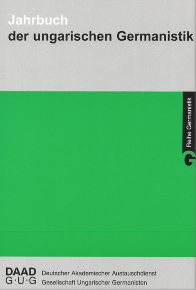Jahrbuch der ungarischen Germanistik 2024, S. 206–217.
Prothetische Zeugenschaft als Alternative im Umgang mit Traumata in W. G. Sebalds Roman „Austerlitz“ (2001)
Károli Gáspár Universität der Reformierten Kirche in Ungarn Budapest
Diese E-Mail-Adresse ist vor Spambots geschützt! Zur Anzeige muss JavaScript eingeschaltet sein!
DOI: https://doi.org/10.69962/JUG.2025.13
Abstract:
W. G. Sebald’s „Austerlitz“ (2001) has been analysed from several aspects in terms of its representation of trauma and memory. The novelty of this study lies in proposing a conceptual parallel between Alison Landsberg’s theory of ‚prosthetic memory‘ and Sebald’s literary engagement with traumatic memories. As the narrative representation of trauma is often problematic, visual modes such as movies and museum exhibitions are widely seen as ‚par excellence‘ alternatives. According to Landsberg, the viewer of these can even acquire a so-called prosthetic memory of the past. However, these representations can turn out to be counterproductive as they traumatise the viewer. By embedding Sebald’s work in this discourse, the paper argues that the fictional witnessing – for which the term ‚prosthetic witnessing‘ is introduced – of the narrator and the reader of „Austerlitz“ is a more productive form of dealing with and preserving traumatic events in cultural and collective memory.
Keywords:
W. G. Sebald, trauma, collective/cultural memory, visual/narrative representation, prosthetic memory, prosthetic witnessing
References:
Arnold-de Simine, Silke (2010): Mediennostalgie als Medienkritik in W. G. Sebalds Austerlitz (2001). In: Böhn, Andreas/Möser, Kurt (Hg.): Techniknostalgie und Retrotechnologie. Karlsruhe: KIT Scientific Publishing, S. 167–181.
Assmann, Jan (2000): Das kulturelle Gedächtnis. Schrift, Erinnerung und politische Identität in den frühen Hochkulturen. München: C. H. Beck.
Baer, Ulrich (2002): Spectral Evidence: The Photography of Trauma. Cambridge/ Massachusetts/London: The MIT Press.
Caruth, Cathy (1996): Unclaimed Experience: Trauma, Narrative and History. Baltimore/ London: The Johns Hopkins UP. https://doi.org/10.1353/book.20656.
Felman, Shoshana/Laub, Dori M. D. (1992): Testimony: Crises of Witnessing in Literature, Psychoanalysis, and History. New York/London: Routledge.
Freud, Sigmund (1939): Der Mann Moses und die monotheistische Religion. Drei Abhandlungen. Amsterdam: Verlag Allert de Lange.
Freud, Sigmund (1999): Über die Deckerinnerung. In: Freud, Anna (Hg.): Gesammelte Werke. Bd. 1. Frankfurt a. M.: Fischer, S. 529–554.
Fuchs, Anne (2004): Die Schmerzensspuren der Geschichte. Zur Poetik der Erinnerung in W. G. Sebalds Prosa. Köln: Böhlau, S. 21–39.
Garloff, Katja (2006): The Task of the Narrator: Moments of Symbolic Investiture in W. G. Sebald’s Austerlitz. In: Denham, S./McCulloh, M. (Hg.): W. G. Sebald: History – Memory – Trauma. Berlin/New York: de Gruyter, S. 157–169. https://doi.org/10.1515/9783110201949.2.157.
Halbwachs, Maurice (1992): On Collective Memory. Chicago/London: The University of Chicago Press.
Hirsch, Marianne (1997): Family Frames: Photography, Narrative, and Postmemory. Cambridge/Massachusetts/London: Harvard UP. https://doi.org/10.1353/yale.2001.0008.
Hirsch, Marianne (2001): Surviving Images: Holocaust Photographs and the Work of Postmemory. In: Zeliser, B. (Hg.): Visual Culture and the Holocaust. London: Athlone, S. 215–246.
Kovács, Edit (2006): Halbdunkel. Zum Beschriften und Lesen von Fotografien in W. G. Sebalds Roman Austerlitz. In: Orosz, M./Albrecht, T. (Hg.): Jahrbuch der ungarischen Germanistik 2005. Budapest/Bonn: Gondolat Kiadói Kör Budapest, S. 87–96.
LaCapra, Dominick (2001): Writing History, Writing Trauma. Baltimore: Johns Hopkins UP., S. 86–113.
Landsberg, Alison (2004): Prosthetic memory: the transformation of American remembrance in the age of mass culture. New York: Columbia UP.
Löffler, Sigrid (2011): Wildes Denken. Gespräch mit Sigrid Löffler (1993). In: Hoffmann, T. (Hg.): W. G. Sebald. »Auf ungeheuer dünnem Eis«. Gespräche 1971 bis 2001. Frankfurt a. M.: Fischer Taschenbuch, S. 82–86.
Mosbach, Bettina/Pethes, Nicolas (2008): Zugzwänge des Erzählens. Zur Relation von Oral History und Literatur am Beispiel von W. G. Sebalds Roman Austerlitz. In: BIOS: Zeitschrift für Biographieforschung, Oral History und Lebensverlaufsanalysen 21 (1), S. 49–69. https://elibrary.utb.de/doi/pdf/10.3224/bios.v21i1.07 (letzter Zugriff am 06.21.2025).
Renner, Rolf G. (2009): Intermediale Identitätskonstruktion: Zu W. G. Sebalds Austerlitz. In: Eke, N. O./Helfer, M. B./Knapp, G. P./Labroisse, G.: W. G. Sebald: Schreiben ex patria/Expatriate Writing. Amsterdam/New York: Rodopi, S. 333–345. https://doi.org/10.1163/9789042027824_022.
Sebald, W. G. (2022): Austerlitz. München: Carl Hanser Verlag.
Sebald, W. G. (1996): Die Ausgewanderten. Vier lange Erzählungen. Frankfurt a. M.: Fischer Taschenbuch.
Sebald, W. G. (2000): Logis in einem Landhaus: Über Gottfried Keller, Johann Peter Hebel, Robert Walser und andere. Frankfurt a. M.: Fischer Taschenbuch.
Scholz, Christian (2011): Aber das Geschriebene ist ja kein wahres Dokument. Gespräch mit Christian Scholz (1997). In: Hoffmann, T. (Hg.): W. G. Sebald. »Auf ungeheuer dünnem Eis«. Gespräche 1971 bis 2001. Frankfurt a. M.: Fischer Taschenbuch, S. 165–175.
Stoisser, Doris (2011): Ein riesiges Netzwerk des Schmerzes. Gespräch mit Doris Stoisser (2001). In: Hoffmann, T. (Hg.): W. G. Sebald. »Auf ungeheuer dünnem Eis«. Gespräche 1971 bis 2001. Frankfurt a. M.: Fischer Taschenbuch, S. 224–251.
Szentivanyi, Christina M. E. (2006): W. G. Sebald and Structures of Testimony and Trauma: There are Spots of Mist That No Eye can Dispel. In: Denham, S./McCulloh, M. (Hg.): W. G. Sebald: History – Memory – Trauma. Berlin/New York: de Gruyter, S. 351–363. https://doi.org/10.1515/9783110201949.3.351.
Van der Kolk, Bessel A./Van der Hart, Onno (1995): The Intrusive Past: The Flexibility of Memory and the Engraving of Trauma. In: Caruth, C. (Hg.): Trauma: Explorations in Memory. Baltimore/London: The Johns Hopkins UP., S. 158–182.
Weigel, Sigrid (1999): Télescopage im Unbewußten. Zum Verhältnis von Trauma, Geschichtsbegriff und Literatur. In: Bronfen, E./Erdle, B. R./Weigel, S. (Hg.): Trauma zwischen Psychoanalyse und kulturellem Deutungsmuster. Köln: Böhlau, S. 51–76.
White, Hayden (1987): The Content of the Form: Narrative Discourse and Historical Representation. Baltimore/London: John Hopkins UP.
